it is important to have the right tools for the job.
This section will
teach you what tools are required for the particular lock you are
attempting to open.
The majority of warded locks come in the form
of padlocks. The tools needed for such a lock can either be made or
purchased at low cost. These being skeleton keys. This type of lock is the
only type which skeleton keys are available for. At this point it should
be noted what a skeleton key actually is in order to dispel any myths
about them.
A skeleton key is simply a key which only consists of
enough metal to open the lock. With the warded lock, with reference to the
mechanisms section, it can be seen that part of the lock does not move,
i.e. the actual ward. This is where a key which only has enough metal to
operate the locking part, comes in. The diagram below illustrates the
function and operation of the skeleton key.
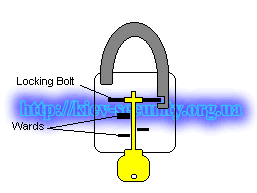
As can be seen, part of the key has been filed
away preventing the key from being stopped by the ward, thus allowing the
remaining end section to come into contact with the locking mechanism and
open the lock.
These skeleton keys can be bought quite
cheaply, however, they can also be made with little difficulty. A skeleton
key for a particular make of a warded lock which opens other locks in the
same series can be made quite easily by removing part of the key which
would be obstructed by the ward. The diagram below shows how a key to a
lock can be made to open other locks of the same series and possibly
warded locks of other manufacturers.
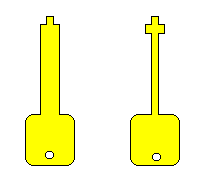
The following illustration depicts other
skeleton keys which can be manufactured.
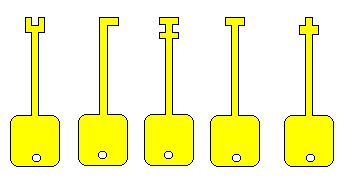
Pin Tumbler &
Wafer
The tools required to open these two types of
locks are similar and will therefore be looked at together.
Unfortunately, contrary to popular belief,
there are no skeleton keys which open this type of lock as is depeicted in
films, but is more down to skill and practise.
Hook Picks
These are for the use of ‘pure picking’ as will
be explained in the techniques section.
All that is needed here is to understand what
they are and to appreciate that they come in a variety of
sizes.
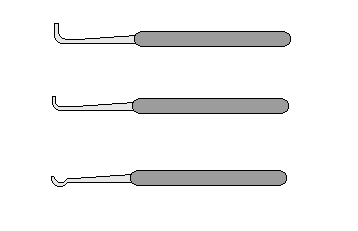
Rakes
Rakes come in a variety of shapes and sizes.
The diagram below shows some fo the major ones.
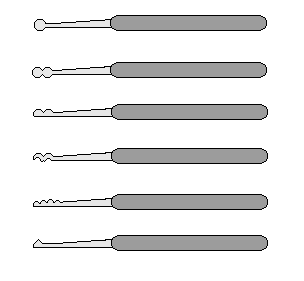
Turning Tools/Tension
Wrench
A vital requirement in the picking of these
types of locks.
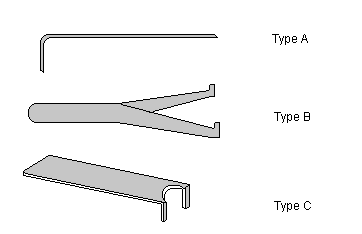
Bypass Pick
This tool can be easily made by grinding a
hacksaw blade to a tapered point similar to that shown below.
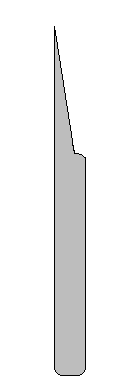
Lever
Lifter Pick
The size of this will be determined by the
lever lock to be picked.
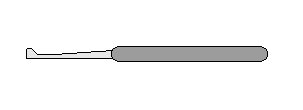
Turning Tool/Tension
Wrench
This tool, although has the same name as that
used for pin and wafer locks, is very different in construction. Both by
way of shape and strength of metal used. The reason for this will be
discussed in the techniques section.
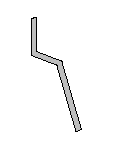
Combination Brief
Case
Combination Probe
This type of probe doesn’t require the strength
of the similar bypass pick used for pin tumbler locks but instead must be
extremely thin.
This probe is for the sole purpose of opening
brief case combination locks.
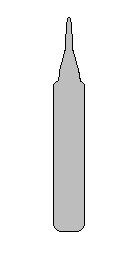
The probe which I constructed for this use was
made from a feeler guage. In particular a number 12
Constructing Picks
Although picks are relatively cheap to purchase
it can often be quite difficult obtaining them and finding outlets which
will sell them to you.
This need not be a serious problem as adequate
picks can be constructed by oneself with a little hardwork and
patience.
In order to make a pick it is a vital
requirement that you have a grinder, as files will not shape the metal
required to make a strong and long lasting pick.
This brings us to an important issue, i.e.,
what metal should be used and where can it be obtained? Well for a pick to
be of any use it must fulfil two main criteria. It must be strong and it
must also be thin, (to get past any fancy key hole which stands between
you and the mechanism).
Such metal can easily be found in the form of
hacksaw blades. These can be marked into the shape of picks by use of a
permanent pen and can then be ground carefully to the shape required. This
metal is extremely useful and can be used to construct the hook picks,
rakes, bypass pick and lever lock lifter pick.
Feeler guage sets, as available from hardware
or automobile shops, also provide metal which can be used. Although some
of these are only useful for shims they can be used for picks or probes,
(especially combination probe), depending on their strength and
thickness.
The metal used for turning tools both for
pintumbler/wafer and lever will vary. For a turning tool used to open a
pin tumbler or wafer lock any springy metal which can be bent to the shape
illustrated above, i.e, the straight forward simple turning tool type A,
without the tool losing its shape will be sufficient.
The lever lock turning tool must be constructed
from a much more rigid and stronger metal. It should be such that once in
the required shape will not bend as it must be able to exert a strong
turning force.

